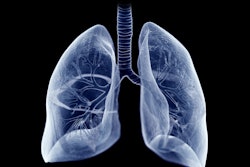
VIENNA - An artificial intelligence (AI) algorithm for pulmonary nodule detection can enable many patients to be discharged earlier from follow-up in lung cancer screening, according to research presented at ECR 2022.
A team of researchers from Noordwest Ziekenhuisgroep in Alkmaar, the Netherlands, retrospectively reviewed 300 patients receiving a follow-up CT exam for an incidentally detected lung nodule. Preliminary results from over 100 patients showed that nearly 20% could have been safely discharged from follow-up based on nodule volumetric analysis by a commercial AI software application.
"We can conclude that AI volumetrics leads to earlier discharge of 1 in 5 patients from follow-up for lung cancer screening," said presenter Dr. Inge Gimbel.
Lung cancer remains the leading cause of cancer death, accounting for nearly 1.8 million deaths per year, according to Gimbel. Effective screening and early detection are critical in reducing mortality.
However, frequent detection of pulmonary nodules leads to an increasing number of CT scans performed. In the U.S. alone, it's been estimated that 1.5 million patients annually are diagnosed with incidental pulmonary nodules, Gimbel said. Moreover, only a small percentage of these nodules will be malignant.
"So in order to save money, it's of great importance to know which patients can be safely discharged earlier," she said.
Under the British Thoracic Society's 2015 guidelines for management of pulmonary nodules, patients with low-risk nodules are recommended to receive a minimum of two years follow-up based on 2D measurements or a minimum of one-year follow-up period based on 3D measurements.
"As these volume measurements are automatically performed by AI, this offers an opportunity for early discharge of these patients, which will lead to a reduction of the number of CT scans, hospital appointments, patient burden, and radiation dose, and all in all, also leads to cost reduction," Gimbel said.
In their recent study, the researchers sought to determine whether using AI to automatically detect and measure pulmonary nodules could lead to earlier discharge from follow-up for cancer screening. They retrospectively gathered a cohort of 300 patients who received CT screening for follow-up of pulmonary nodules in 2020.
Version 3.9.3 of Veye Lung Nodules (Aidence) had been applied then to the CT studies, but the volume measurements were not used to discharge patients earlier from screening follow-up, Gimbel said. The software was set at an operating point of 0.85, as well as a filter of 4 mm to detect all nodules 4 mm and larger.
In Vienna, Gimbel shared preliminary results from 108 patients in the study. Out of these patients, volume measurements from the AI software could have been used to discharge 20 (18.5%) from follow-up.
Based on estimates from the number and cost of CT lung cancer screening exams in the U.S., the AI software could save roughly $80 million each year, according to Gimbel.
"So using AI volumetrics is of great importance to reduce costs," she said.
Gimbel acknowledged the results so far were preliminary and that no definite conclusions can be drawn yet. Moreover, it was a retrospective study with a short follow-up period. And AI can also produce false-positive results and incorrect measurements, she said.
"So a radiologist is needed to check these measurements," she said.




















